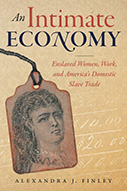An Intimate Economy: Enslaved Women, Work, and America’s Domestic Slave Trade

Author: Alexandra J. Finley
Publisher: The University of North Carolina Press, 2020. 200 pages
Reviewer: Christy Clark-Pujara ǀ November 2021
Alexandra Finley’s An Intimate Economy highlights how the work of women undergirded the Domestic Slave Trade in antebellum America, specifically in Richmond, Virginia and New Orleans, Louisiana. While scholars of slavery and capitalism have detailed how enslavers, slave-traders, bankers, transportation companies, and slave-trading firms were instrumental in the expansion of modern capitalism, the domestic labor that facilitated the actual sales on the auction block has been largely ignored. Through diligent research, Finley reminds us that before enslaved people were put on the auction block they were housed in slave jails cleaned by women. And, that the captives were bathed, fed, nursed, groomed and clothed by women.
Finley convincingly asserts that the lived experiences of the women who labored in the domestic economy of the slave trade are critical to a full accounting and understanding of the trade. She does this by telling us the life stories of women who represent four categories of female laborers: fancy girls—enslaved females who were marketed especially for white male pleasure; seamstresses—free and enslaved women that made “sale outfits;” concubines—enslaved and free women who performed the duties of a wife with none of the social and legal protections of marriage; and housekeepers—enslaved and free women who raised children and ran households. Through four microhistories, Finley demonstrates how sexual and racial conceptions and divisions of domestic work contributed to the expansion of capitalism and shaped the lives of women. She defines domestic labor as the work of running a household, socially reproductive labor as giving birth, feeding, clothing, cleaning and otherwise caring for people of all ages, and the sexual economy as the commodification of enslaved women’s fertility and sexuality. Through the careful reconstruction of the lives of Corinna Omohundro, Sarah Ann Conner, and Lucy Ann Cheatham, and fragments she was able to pull together of other women’s lives, Finley highlights the invisible, but vital work of women in the Internal Slave Trade. Many of the women featured in An Imitate History were “light skinned” and of mixed racial heritage, and some even passed for white; however, the author moves beyond the static trope of the “tragic mulatto,” and illuminates the array of coerced physical, emotional, sexual and intellectual labor that these women performed. Moreover, Finley explores and makes visible the covert and overt modes of resistance that these women employed as they strove to live full lives, and secure the futures of their children in bondage and freedom. Her thorough and exhaustive research is grounded primarily in the account books of slave-traders, court records, city census data, and personal correspondence.
Finley introduces us to women who do not fit neatly into any category. Legally and practically, they move from enslavement to freedom and sometimes even to enslaver, from dependence to independence, from concubine to wife and/or widow, from social pariah to socialites, and sometimes even from Black to white. The first chapter focuses on the life of Corinna Omohundro, who was held in bondage as a fancy girl and bore the children of her enslaver, while running his household and assisting in his slave-trading business and managing his boardinghouse. Omohundro wore expensive dresses and jewelry, while providing clothing for those sold on the auction block. She and her children remained the chattel property of Silas Omohundro until he freed them in his will in 1864. Her forced labors—physical, sexual, emotional and intellectual—allowed Silas Omohundro to build thriving businesses.
Chapter 2 explores the lives of seamstresses who made the utilitarian sale outfits that many enslaved captives wore to the auction block. These women were also employed as cooks, cleaners and groomers. They prepared people for market. They bathed them, dyed and combed their hair, tended wounds, and fed them. Some of the seamstresses were enslaved; others were free Black women in search of piece work; and some were skilled dressmakers who clothed fancy girls. Finley poignantly reminds readers that “in the clothing industry, the invisible hand of the market was actually a very visible, tired, and female hand whose freedom depended on the meaning attached to its particular hue” (p. 67).
Chapters 3 and 4 tell the life stories of three enslaved women, one of whom became an enslaver. Over her lifetime, Sarah Ann Conner was legally defined as a slave, concubine, and free woman of color. While being rented out as an enslaved concubine or prostitute, she was able to earn enough money renting rooms and taking in laundry to buy herself. Conner lived as free woman for several years and even purchased two enslaved people — but her freedom was nearly revoked when Theophilus Freeman, the man she paid to negotiate and purchase her freedom, failed to pay his debts. Freeman had failed to register her emancipation, so in the eyes of his debtors she was part of his estate. Conner petitioned for her freedom and eventually was legally recognized as free when the Louisiana State Supreme Court ruled in her favor. She lost her slave property in the process.
Lucy Ann Cheatham was purchased by the man others would later refer to as her husband. She was an enslaved housekeeper who was also tasked with performing sexual labor and bearing her enslaver’s children. In freedom, Cheatham labored and worked as a landlady. Much of Cheatham’s story comes from an interview given by her life-long friend Mary Lumpkin, who like Cheatham spent much of her life caught in the webs of the sexual economy of slavery. Throughout this monograph Finley highlights how these women created networks with each other, and with customers, enslavers, and former enslavers in order to survive — and how they attempted to gain some autonomy over their lives in a legal system that was designed to exploit and marginalize them.
The author is careful to remind her readers that these women’s “choices” must be understood within the context of the world in which they lived; they had little to no access to physical and emotional safety; their ability to support themselves was severely restricted by their sex, race and status; and they were not recognized as citizens even as freedom persons. These women provided essential labor and were required to be happy and obedient in order to protect themselves and their children. Finley goes to great lengths to fully humanize the experiences of the women she researched. She does not allow her readers to forget the emotional and physical stresses that these women faced on a daily basis. She is also very honest about her disparate sources base. The lives of enslaved women are notoriously difficult to research; their lives must often be reconstructed from fragmentary historical documents, and from the records of those who held them in bondage. Finley deftly uses the silence of the archives to raise questions, and to pose historically sound and probable scenarios; she weaves the records of multiple women to speak to the lives of other women who were in similar circumstances, and she reminds readers that there were often no good choices.
It would have been useful for the author to layout more of the historical details of the Domestic Slave Trade, specifically who and how many people were trafficked, from where they were primarily trafficked, and the modes of their forced travel. Also, while she does a great job of drawing her reader in with personal stories, the use of multiple stories in some of the chapters was sometimes overwhelming and confusing.
Those critiques aside, An Intimate Economy is an engaging and accessible narrative that will appeal to scholars as well as general readers. Alexandra Finley carefully and brilliantly connects scholarships of slavery, capitalism and women’s studies. This book is particularly well suited for the college classroom and graduate seminar because she does such a wonderful job of explaining her use of sources and method, while telling very compelling stories.
Christy Clark-Pujara is an Associate Professor of History in the Department of Afro-American Studies at the University of Wisconsin-Madison


